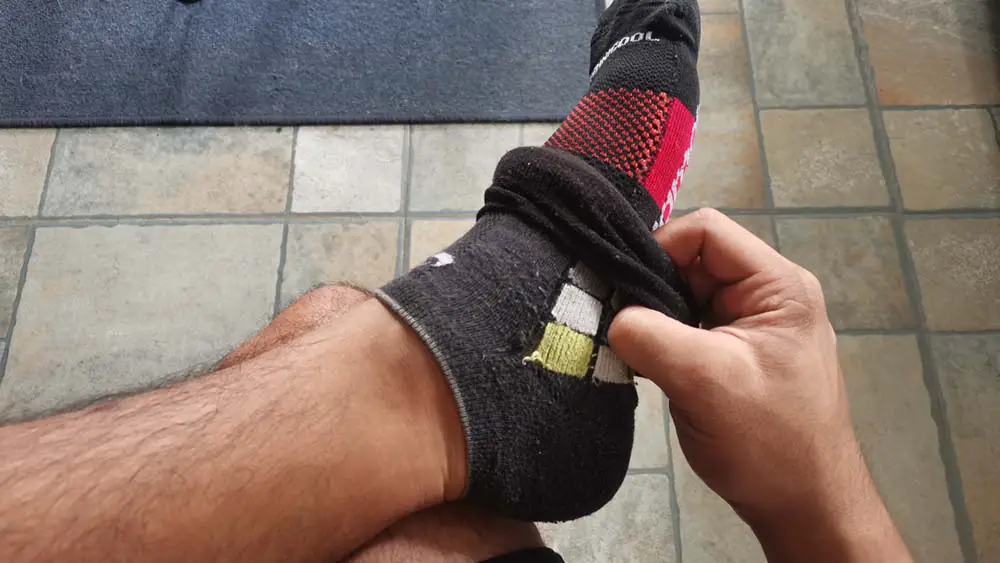This post contains affiliate links.

I was sitting on my couch when I read a tip about doubling up your socks when running to improve comfort and prevent blisters. I wanted to know whether it’s actually effective so I grabbed two pairs of thin cotton socks and ran 15 km. Here’s what I noticed:
Wearing 2 pairs of socks when running can help prevent blisters. The friction that normally occurs between the skin and the socks will transfer between the 2 socks. It can also help runners improve the fit of a loose shoe. Just be sure you don’t wear two thick pairs of socks when doubling up.
However, I still don’t recommend it despite the number of athletes who swear by it. There is another effective way of preventing blisters that doesn’t involve doubling up the number of socks in the laundry. Ahead, we will look at the pros and cons of doubling up and another effective way to prevent blisters. Let’s get started.
Does Wearing 2 pairs Of Socks Work?
To find out whether wearing two pairs of socks really works in preventing blisters and improving comfort, I went out and tested it.
How I tested it: For this test, I wanted to give myself the best opportunity to get blisters and find out whether wearing two pairs of socks can really prevent them. So I ran 15km wearing 2 pairs of thin cotton socks in my least favorite shoe.
But why cotton socks? Socks made of synthetic fibers like polyester, wool, and nylon can prevent blisters. I wanted to eliminate the possibility that I didn’t get blisters because of the effectiveness of running socks.
So I wore two pairs of thin cotton socks—the same type of socks I wore when I ran my first 10k and got blisters in my forefoot—to find out whether doubling up would actually prevent blisters and improve comfort.
The result: I found that wearing two pairs of socks works in preventing the development of blisters in my foot. I felt that my foot wasn’t getting the same friction I get when wearing a single pair of thin cotton socks. It felt like the two socks just glided against each other and that the inner socks acted like another layer of skin.
Pros Of Doubling Up
Prevents blisters – Just as we’ve talked about earlier, wearing two pairs of socks is effective at preventing blisters.
Improves cushion – Wearing two pairs of socks adds another layer of cushion which could be useful in long-distance runs.
Provides better insulation – When it’s extra cold outside, you might need some extra insulation in your foot to be able to run longer. Wearing 2 pairs of socks might be a good solution.
Improves the fit of a loose shoe – For runners with thin feet, there are times that despite getting the right shoe size, the shoe’s overall fit is just too loose. Wearing 2 pairs of socks is a great way to increase the snugness of the shoe.
Cons Of Doubling Up
You’re adding more socks to your laundry – Perhaps one of the most obvious disadvantages of wearing 2 pairs of socks is more laundry. Double your socks, double the number of socks you have to wash.
It may be unnecessary – Sure, wearing two pairs of socks can help prevent blisters, however, that may be unnecessary. There are lots of good running socks that prevent blisters without having to double up. My favorite is the Balega Ultraglide friction-free socks. You can buy them on Amazon.
It decreases responsiveness – If you’re looking forward to running fast, take note that wearing two pairs of running socks can decrease responsiveness and potentially make you slower.
It messes with the fit of your shoes – Wearing two pairs of running socks can get really tight on your shoes. So unless your foot is really thin for your shoes, wearing two pairs of socks may not work very well for you.
It makes it less breathable – More layers of socks will obviously result in a decrease in breathability. That said, I believe doubling up isn’t the best idea for the summer months.
Runners Aren’t The Only Ones Doing It
Runners aren’t the only ones doubling up to prevent getting blisters and increase comfort during athletic activities.
This trick works so well in blister prevention that even professional basketball and tennis players, hikers, and athletes from other sports where foot blisters are common use two pairs of socks.
Also read: Best Running Socks That Don’t Slip Down (And How To Spot Them)
What Socks To Wear When Doubling Up
In the test I did, I used two cotton socks to give myself the biggest opportunity to get blisters and see whether wearing two socks can stop it, but you shouldn’t really wear cotton socks at all when you’re running. I covered 5 reasons why you shouldn’t wear cotton socks in another article.
Here’s what you should wear instead:
The first layer should be a thin sock made of synthetic fabrics such as polyester, nylon, and wool. They’re designed to wick away moisture and dry quickly. Both features are important for running because comfort is the utmost priority in long-endurance sports. Plus, moisture increases friction which is the main cause of blistering for runners. My favorite thin sock is the Rockay Agile (link to Amazon) which I feel is the best thin sock out there.
(Related article: Thick Or Thin Running Socks: Which One Should You Get?)
The first layer will act like another layer of skin that will protect your real skin against friction from repetitive movement. It will also repel moisture keeping your feet fresh and dry in those long miles.
Like the first layer, the second layer should still be socks made of synthetic fabrics to prevent moisture build-up. It could be the same socks or a slightly thicker sock if you want more insulation. Think of socks like SmartWool (link to Amazon) which are made of Merino wool.
To give you an idea of how you could use two pairs of socks, here’s what I would do if I were to wear two socks:
- I’d wear two Rockay Agile if it’s hot. Rockay Agile is thin and breathable which could work well even if you wear two socks.
- When it’s cold, I’d wear Rockay Agile + SmartWool PhD Mid Crew Light. SmartWool is made of Merino wool which is the best in thermoregulation without having to be too thick—important if you don’t want your shoe to feel too cramped up.
You Don’t Have To Wear Two Socks To Prevent Blisters
Although wearing two socks is effective in preventing blisters, you don’t actually have to do it. There are ways—which I believe are more efficient—to prevent blistering without having to pile more socks in the laundry bag.
Simply get good running socks.
I used to get blisters all the time until I invested in multiple pairs of good running-specific socks. They have built-in technology designed to provide runners with maximum comfort during a run.
Some examples of these are extra cushioning/padding in usual blister areas, support for the ankles and arches, and vents for improved breathability.
If you’re not convinced with running socks, check out the article that I made comparing them to regular socks.
Alternatively, I made a list of running socks that I and other runners swear by to prevent blisters. I’ve also included a short review of them. You can check out the list here.
My Favorite Running Socks
If you want to take a quicker approach and just use the same socks I use, here are my recommended running socks for different situations:
- For cold weather: SmartWool socks – they are thicker and warmer than the other socks that I’ve tried.
- For hot weather: Balega Silver No-Show Socks
- If you get frequently blisters in between your toes: Injinji socks
- For trail running: MudGear Premium Compression Socks

